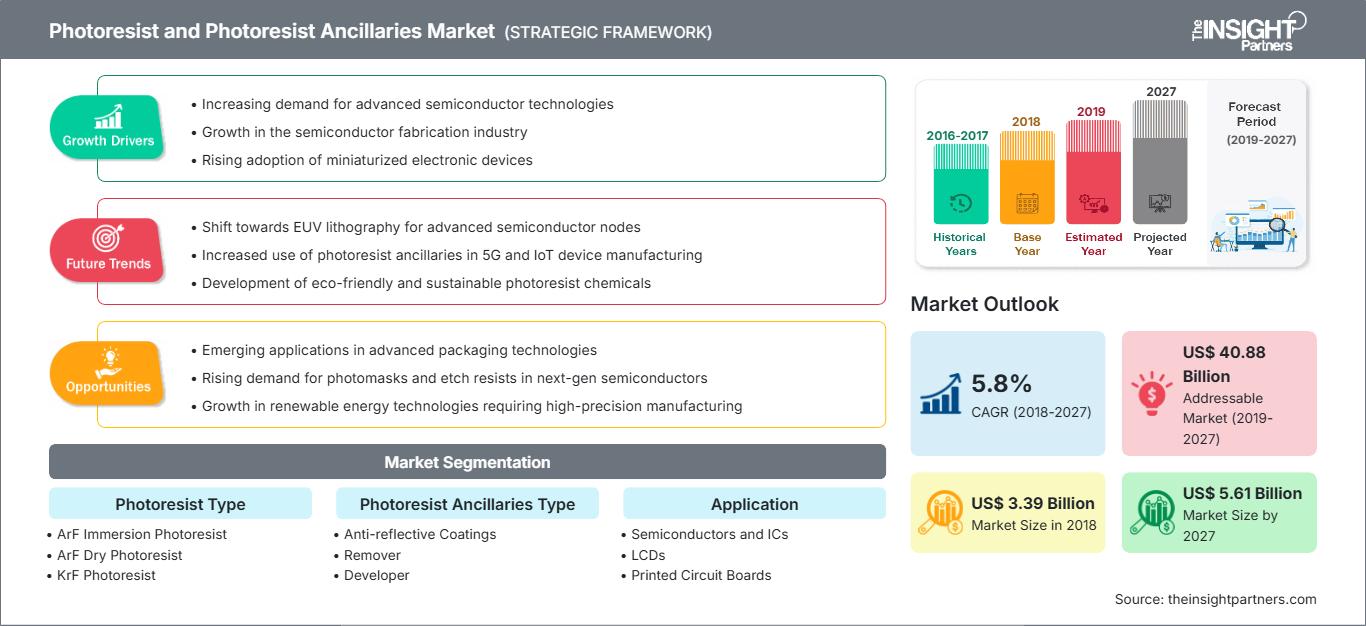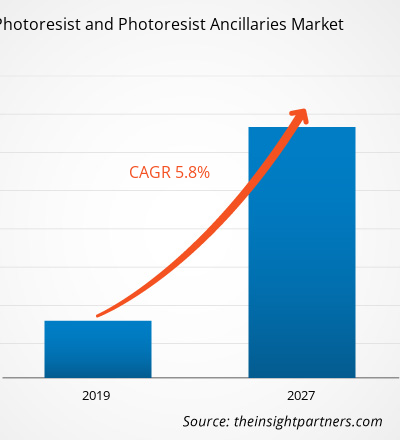El mercado de fotorresistencias y sus accesorios se valoró en US$ 3.392,97 millones en 2018 y se proyecta que alcanzará los US$ 5.614,37 millones para 2027; se espera que crezca a una CAGR del 5,8% entre 2019 y 2027.
Las fotorresistencias son resinas poliméricas fotosensibles que se utilizan principalmente en la producción de circuitos impresos, planchas de impresión, pantallas planas de cristal líquido, cabezales de grabación magnética y sistemas microelectromecánicos (MEMS). Estos componentes sirven como materiales de enmascaramiento para la transferencia de imágenes a un sustrato subyacente mediante procesos de grabado. Los auxiliares de las fotorresistencias son materiales como decapantes, recubrimientos antirreflectantes, reveladores y removedores de bordes que se utilizan junto con la fotorresistencia. Las fotorresistencias y sus auxiliares se utilizan en la configuración del cableado de semiconductores multicapa para la fabricación de ordenadores, portátiles, reproductores de música, teléfonos, servidores y electrodomésticos. La industria electrónica experimenta un crecimiento constante tanto en los países desarrollados como en desarrollo. Las empresas que operan en este campo utilizan fotorresistencias y sus auxiliares en la fabricación de productos como teléfonos avanzados, sistemas informáticos, televisores y equipos de entretenimiento doméstico, así como dispositivos electrónicos de control y monitorización utilizados en numerosas aplicaciones industriales y científicas.
Se espera que Norteamérica crezca a la tasa de crecimiento anual compuesta (TCAC) más alta, del 6,0 %, durante el período de pronósticos. Varias empresas nacionales e internacionales tienen una sólida presencia en Norteamérica. Estas empresas mejoran continuamente sus procesos comerciales para satisfacer la demanda de los clientes de la mejor manera posible. En Norteamérica, Estados Unidos es un mercado importante para la fotorresistencia y sus accesorios, seguido de Canadá y México.
El brote de COVID-19 comenzó en Wuhan (China) en diciembre de 2019 y, desde entonces, se ha propagado rápidamente por todo el mundo. China, Italia, Irán, España, la República de Corea, Francia, Alemania y Estados Unidos se encuentran entre los países más afectados en cuanto a casos positivos y fallecimientos notificados hasta marzo de 2020. Según las últimas cifras de la OMS, hay unos 332.930 casos confirmados y un total de 14.510 fallecimientos a nivel mundial. El brote de COVID-19 ha afectado a las economías e industrias de varios países debido a confinamientos, prohibiciones de viaje y cierres de empresas. La industria química y de materiales a nivel mundial es una de las principales que ha sufrido graves interrupciones, como interrupciones en la cadena de suministro, cancelaciones de eventos tecnológicos y cierres de oficinas, como consecuencia de este brote. Por ejemplo, China es el centro mundial de la fabricación y el mayor proveedor de materias primas para diversas industrias. El colapso general del mercado debido al COVID-19 también está afectado el crecimiento del mercado de fotorresistencia y sus auxiliares debido al cierre de fábricas, obstáculos en la cadena de suministro y recesión en la economía mundial.
Personalice este informe según sus necesidades
Obtendrá personalización en cualquier informe, sin cargo, incluidas partes de este informe o análisis a nivel de país, paquete de datos de Excel, así como también grandes ofertas y descuentos para empresas emergentes y universidades.
Mercado de fotorresistencias y sus auxiliares: perspectivas estratégicas

-
Obtenga las principales tendencias clave del mercado de este informe.Esta muestra GRATUITA incluye análisis de datos, desde tendencias del mercado hasta estimaciones y pronósticos.
Perspectivas del mercado
La creciente demanda de diversas aplicaciones ha favorecido el mercado de fotorresistencias y sus auxiliares a nivel mundial.
La creciente demanda de diversas aplicaciones, como semiconductores y circuitos integrados (CI), pantallas LCD y placas de circuito impreso (PCB), está impulsando el mercado de fotorresinas y sus accesorios en todo el mundo. Uno de los factores clave de crecimiento para este mercado es su uso en pantallas planas. Al ser más delgadas, ligeras y energéticamente eficientes, estas pantallas se prefieren a otras, lo que impulsa el crecimiento del mercado en países desarrollados y en desarrollo como Estados Unidos, Reino Unido, Italia, China, India, Rusia, Japón, México y Canadá. Además, las fotorresinas también se utilizan en la configuración del cableado en la fabricación de semiconductores multicapa, un componente clave de portátiles, ordenadores, reproductores de música, teléfonos, servidores y electrodomésticos. Las fotorresinas son resinas poliméricas fotosensibles que se utilizan principalmente en la producción de placas de circuito impreso, planchas de impresión, pantallas planas de cristal líquido, cabezales de grabación magnética y sistemas microelectromecánicos (MEMS). Estos componentes sirven como materiales de enmascaramiento para la transferencia de imágenes a un sustrato subyacente mediante procesos de grabado. Los auxiliares de fotorresistencia son materiales tales como removedores de fotorresistencia, recubrimientos antirreflejos, reveladores y removedores de bordes utilizados junto con la fotorresistencia.
Perspectivas de la aplicación
Según la aplicación, el mercado de fotorresistencias y sus accesorios se segmenta en fotorresistencia de inmersión ArF, fotorresistencia seca ArF, fotorresistencia KrF y fotorresistencias de línea G e línea I. En 2018, el segmento de fotorresistencia de inmersión ArF representó la mayor participación del mercado global de fotorresistencias y sus accesorios; sin embargo, se espera que el segmento de fotorresistencias de línea G e línea I crezca a una mayor tasa de crecimiento anual compuesta (TCAC) durante el período de pronóstico. Se consideran una excelente ventana de proceso que presenta uniformidad en la dimensión crítica (CD), lo que permite una mejor forma del perfil del producto. Estos productos satisfacen las necesidades del creciente número de consumidores urbanos de clase media, dispuestos a pagar un precio superior por fotorresistencias y sus accesorios.
Información sobre los tipos de accesorios de la fotorresistencia
Según el tipo de auxiliares fotorresistentes, el mercado de estos se segmenta en recubrimientos antirreflectantes, removedores, reveladores y otros. El segmento de recubrimientos antirreflectantes representó la mayor participación en el mercado global de estos auxiliares; sin embargo, se espera que el segmento de removedores registre la tasa de crecimiento más rápida durante el período de pronóstico. Los recubrimientos antirreflectantes se clasifican como auxiliares fotorresistentes, que ayudan a controlar la reflexión y absorben la luz durante la fotolitografía. Poseen diversas propiedades favorables, como la supresión de múltiples reflexiones y la mejora del contraste. Estos recubrimientos contribuyen directamente a la reducción de los costos operativos de los procesos del sector electrónico. Los recubrimientos antirreflectantes facilitan la transición de los procesos tradicionales de 365 nm (línea I) a los métodos de inmersión de vanguardia de 193 nm. Estos materiales ofrecen una ventana de proceso dinámica, una amplia compatibilidad con fotorresistentes y el patrón deseado.
Perspectivas regionales del mercado de fotorresistencias y sus accesorios
Los analistas de The Insight Partners han explicado detalladamente las tendencias regionales y los factores que influyen en el mercado de fotorresinas y sus accesorios durante el período de pronóstico. Esta sección también analiza los segmentos y la geografía del mercado de fotorresinas y sus accesorios en América del Norte, Europa, Asia Pacífico, Oriente Medio y África, y América del Sur y Central.
Alcance del informe de mercado sobre fotorresistencias y sus accesorios
| Atributo del informe | Detalles |
|---|---|
| Tamaño del mercado en 2018 | US$ 3.39 mil millones |
| Tamaño del mercado en 2027 | 5.610 millones de dólares estadounidenses |
| CAGR global (2018-2027) | 5,8% |
| Datos históricos | 2016-2017 |
| Período de pronóstico | 2019-2027 |
| Segmentos cubiertos |
Por tipo de fotorresistencia
|
| Regiones y países cubiertos |
América del norte
|
| Líderes del mercado y perfiles de empresas clave |
|
Densidad de actores del mercado de fotorresistencias y sus auxiliares: comprensión de su impacto en la dinámica empresarial
El mercado de fotorresinas y sus accesorios está en rápido crecimiento, impulsado por la creciente demanda del usuario final debido a factores como la evolución de las preferencias de los consumidores, los avances tecnológicos y un mayor conocimiento de los beneficios del producto. A medida que aumenta la demanda, las empresas amplían su oferta, innovan para satisfacer las necesidades de los consumidores y aprovechan las tendencias emergentes, lo que impulsa aún más el crecimiento del mercado.

- Obtenga una descripción general de los principales actores clave del mercado de fotorresistencias y sus accesorios.
Cobertura del informe
Mercado global de fotorresistencias y sus accesorios (por tipo)
- Fotorresistencia de inmersión ArF
- Fotorresistencia seca ArF
- Fotorresistencia KrF
- Fotorresistencia de línea G y línea I
Mercado global de fotorresistencias y sus accesorios (por tipo)
- Recubrimientos antirreflectantes
- Agente de mudanzas
- Revelador
- Otros
Mercado global de fotorresistencias y sus auxiliares (por aplicación)
- Semiconductores y circuitos integrados
- Pantallas LCD
- Placas de circuito impreso
- Otros
Perfiles de empresas
- MERCK KGaA
- Compañía química Sumitomo, Ltd.
- TOKIO OHKA KOGYO CO., LTD
- Tecnología de microresistencia GmbH
- Compañía química Shin-Etsu, Ltd.
- ALLRESIST GmbH
- DJ Microlaminados, Inc.
- DuPont de Nemours, Inc.
- Corporación Fujifilm
- Corporación JSR
- Análisis histórico (2 años), año base, pronóstico (7 años) con CAGR
- Análisis PEST y FODA
- Tamaño del mercado, valor/volumen: global, regional y nacional
- Industria y panorama competitivo
- Conjunto de datos de Excel
Informes recientes
Testimonios
Razón para comprar
- Toma de decisiones informada
- Comprensión de la dinámica del mercado
- Análisis competitivo
- Información sobre clientes
- Pronósticos del mercado
- Mitigación de riesgos
- Planificación estratégica
- Justificación de la inversión
- Identificación de mercados emergentes
- Mejora de las estrategias de marketing
- Impulso de la eficiencia operativa
- Alineación con las tendencias regulatorias






















 Obtenga una muestra gratuita para - Mercado de fotorresistencias y sus accesorios
Obtenga una muestra gratuita para - Mercado de fotorresistencias y sus accesorios